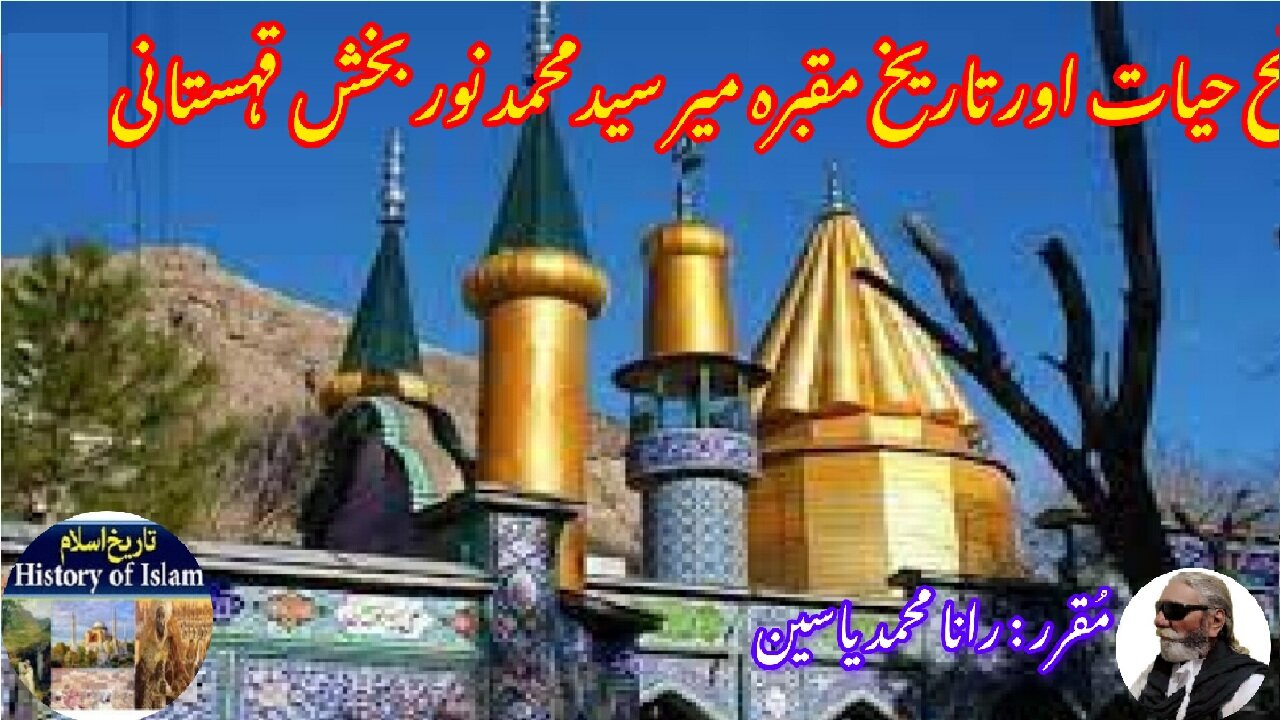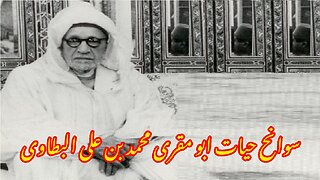Premium Only Content

Nurbakhsh Qahistani and history of his shrine نوربخش قہستانی کی سوانح عمری اور مزار کی تاریخ
@islamichistory813 #mir #syed #muhammad #nurbakhsh #qahistani #sufisaint #cultural #heritage #biography #islamic #mysticism #islamic #philosophy #shrine #historical #figures
Biography of Mir Syed Muhammad Nurbakhsh Qahistani and the history of his shrine
Dekhti Aankhooon aur sountay kaanoon ko Asslamoalaikum, sisters, brothers friends and elders, in informative series videos of Islamic ascolars, sufisaints, cultural heritages, islamic philosophys, islamic mysticisms and historical figures. today we are describing biography of Mir Syed Muhammad Nurbakhsh Qahistani and the history of his shrine.
Mir Syed Muhammad Nurbakhsh Qahistani (1392–1464) was a renowned Islamic scholar, mystic, and Sufi who founded the Nurbakhshiyya school of Islam, which has had a significant influence on Sufi practices in Persia and beyond. He was born in Qahistan, a region located in the present-day northeastern part of Iran, and his contributions to Islamic jurisprudence, theology, and mysticism remain profound to this day. Nurbakhsh was not only known for his deep spirituality but also for his scholarly works, particularly his writings, "Fiqh al-Ahut" (Islamic Jurisprudence) and "Kitab al-Atiqadiyya" (Book of Creed), both of which have served as important texts in Islamic jurisprudence and the philosophy of Sufism.
Nurbakhsh’s influence on Sufism was profound, particularly through his establishment of the Nurbakhshiyya order, which became an important branch of Sufism in the 15th century. The Nurbakhshiyya order was based on the principles of deep spiritual contemplation, self-discipline, and the pursuit of knowledge through both inward and outward means. Nurbakhsh’s teachings emphasized the importance of a personal connection to the divine and the purification of the soul through ascetic practices, which included meditation, prayer, and the cultivation of inner peace. His focus on the relationship between a disciple and the spiritual guide (sheikh) was integral to the structure of his school, and this relationship was thought to facilitate the journey toward spiritual enlightenment and closeness to God.
In addition to his spiritual and theological work, Nurbakhsh was also involved in the intellectual currents of his time. He was a respected scholar of Islamic jurisprudence and theology, having written key works that helped consolidate his ideas. His "Fiqh al-Ahut" was a significant contribution to Islamic legal thought, as it offered insights into Islamic jurisprudence, providing guidance on legal matters for the Sufi community. His "Kitab al-Atiqadiyya" outlined his views on Islamic creed, focusing on the essential beliefs and practices of the Sufi path. These works cemented his position not only as a spiritual leader but also as an intellectual force in the Islamic world during the 15th century.
Mir Syed Muhammad Nurbakhsh passed away in 1464, leaving behind a lasting legacy as one of the leading figures in the development of Sufi mysticism. His death marked the end of a distinguished life dedicated to the pursuit of spiritual and intellectual growth, but his teachings and the Nurbakhshiyya order continued to influence generations of Sufis long after his passing. The Nurbakhshiyya order expanded significantly after his death, with many of his disciples spreading his teachings throughout Persia, Central Asia, and parts of India.
Nurbakhsh’s mausoleum, which serves as a site of pilgrimage and spiritual reflection, is located in the city of Mashhad, Iran. Mashhad, one of the most revered cities in the Islamic world, is known for housing the shrine of Imam Ali, but it is also home to the mausoleums of many prominent figures in Islamic history, including Mir Syed Muhammad Nurbakhsh. His tomb is a place of great spiritual significance for those who follow the Nurbakhshiyya order and for anyone interested in his contributions to Islamic mysticism and jurisprudence.
The mausoleum of Mir Syed Muhammad Nurbakhsh was constructed by his disciples and followers shortly after his death, as a testament to his profound influence and the respect he commanded among his adherents. As a leading figure in the spiritual and intellectual life of the time, Nurbakhsh’s death left a void that his followers sought to fill by honoring him with a monumental structure dedicated to preserving his legacy. The construction of the mausoleum was a collaborative effort among his closest disciples, who wanted to ensure that his teachings would continue to inspire future generations. The mausoleum was built with an architectural style typical of the period, reflecting both Islamic and Persian artistic traditions, and was designed to be a place of quiet reflection, prayer, and connection to the divine.
The shrine itself features intricate Islamic architectural details, including a large dome, decorative tiles, and inscriptions of Nurbakhsh’s teachings. The design of the mausoleum is meant to create a space that fosters contemplation and spiritual elevation. Over the centuries, the mausoleum has become a revered pilgrimage site for Sufis, scholars, and devotees who seek to honor the memory of Mir Syed Muhammad Nurbakhsh and to gain spiritual insight from his teachings.
Today, the shrine of Nurbakhsh remains an important destination for those seeking to connect with his spiritual legacy. Pilgrims visit the mausoleum not only to pay their respects to the great Sufi scholar but also to meditate upon his teachings, which continue to be a source of inspiration for many in the fields of mysticism, theology, and Islamic jurisprudence. The Nurbakhshiyya order, although it is less widespread than some other Sufi orders, still maintains a devoted following, and the shrine continues to serve as the spiritual center for its adherents.
In conclusion, Mir Syed Muhammad Nurbakhsh, who died in 1464, was a significant figure in the development of Sufism and Islamic jurisprudence. His writings and teachings formed the basis of the Nurbakhshiyya order, which has continued to influence Islamic mysticism for centuries. His mausoleum, located in Mashhad, Iran, stands as a lasting tribute to his life and work, built by his disciples shortly after his death. Today, it remains a place of pilgrimage and reflection for those who seek to honor his memory and learn from his spiritual and intellectual contributions.
With this, we seek your permission until tomorrow, tomorrow we will describe the biography of Syed Ahmadullah Maizbhandari and the history of his Shrine.
Allah Hafiz
==============================
-
 7:26
7:26
ISLAMIC HISTORY
19 hours agoBiography of Abu Muqri Muhammad ibn Ali al-Batawi سوانح عمری ابو مقری محمد ابن علی البتاوی
1 -
 38:21
38:21
Stephen Gardner
2 days ago🔥Is Kash Patel HIDING DETAILS About Charlie Kirk & Jeffrey Epstein? Judge Joe Brown
66.1K192 -
 26:33
26:33
DeVory Darkins
1 day ago $58.50 earnedRep Omar EMBARRASSES herself in a painful way as Newsom PANICS over Kamala confrontation
98.1K326 -
 3:28:14
3:28:14
Badlands Media
1 day agoThe Narrative Ep. 39: The Sovereign Mind
125K39 -
 2:17:35
2:17:35
TheSaltyCracker
12 hours agoThe Charlie Kirk Effect ReeEEStream 9-21-25
137K373 -
 2:03:07
2:03:07
vivafrei
12 hours agoEp. 283: Charlie Kirk Memorial and other Stuff in the Law World
235K209 -
 9:13:12
9:13:12
The Charlie Kirk Show
23 hours agoLIVE NOW: Building A Legacy, Remembering Charlie Kirk
2.19M966 -
 1:55:20
1:55:20
The White House
15 hours agoPresident Trump Participates in the Memorial Service for Charlie Kirk
120K97 -
 1:02:41
1:02:41
Sarah Westall
14 hours agoDomestic Terror Operation: Death Threats, Smear Campaigns, Gang Stalking w/ Journalist Sarah Fields
76.1K11 -
 1:51:40
1:51:40
Nerdrotic
14 hours ago $26.25 earnedGobekli Tepe Discovery and "Reconstruction" | Forbidden Frontier #118
113K14